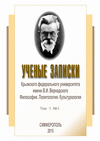The significance of drought in the Rigveda and its close relationship with the philosophical and theological concepts of the Vedic worldview is analyzed in this article. Naturein the hymns and verses of the Rigveda is not only actively mentioned but also personified, with elements like the sun, wind, and rivers assuming the roles of deities. In the Rigveda, droughtis viewed not merely as a natural disaster but as a significant theological event reflecting the complex relations between humans and the divine world. Drought symbolizes not only a physical lack of water but also a cosmic order disruption, divine discontent, and is often associated with the concept of karma, thereby linked to human actions. Vedic thought suggests that drought arises due to divine discontent over improper veneration of their status or immoral actions, leading to a disconnection between the human world and the world of the gods. Conversely, rituals and prayers play a crucial role in overcoming this imposed calamity, serving as a means to restore cosmic order, appease the gods, and ensure the much-needed rain. Typically, rituals are aimed at gaining the favor of those gods responsible for rain and fertility. The Rigvedahymns repeatedly praise their actions directed at releasing water held back by drought demons.Performing appropriate rituals is seen not just as a plea for rain but also as a means to restoreharmony between humans and the divine world. The emphasis on these practices in the Vedictradition underscores a deep belief in the ritual actions power, capable of influencing naturalphenomena and maintaining balance in the universe. Thus, drought in the Rigveda is viewed as an important symbolic element, through which the philosophical and religious idea is expressed that the society well-being depends on adhering to the proper cosmic and spiritual order.
Veda, Vedic philosophy, natural phenomena, Hindu religious texts.
1. Parallel'nyy korpus Rigvedy (n. d.). URL: https://samskrtam.ru/parallel-corpus/01_rigveda.html (data obrascheniya 10.07.2024).
2. Pargiter F.E. The Markandeya Purana Translated with Notes. Calcutta: Baptist Mission Press, 1904.
3. Kane P.V. History of Dharmasastra (Ancient and Mediaeval Religious and Civil Law in India). Poona: Bhandarkar Oriental Research Institute, 1968–1977. Vol. 2. Pt. 2.
4. Radhakrishnan S. The Bhagavadgita: With an Introductory Essay, Sanskrit Text, English Translation and Notes. London: George Allen & Unwin, 1948.
5. Jamison S.W., Brereton J.P. The Rigveda: The Earliest Religious Poetry of India. Oxford: Oxford University Press, 2014.
6. Doniger W. The Rig Veda: An Anthology of One Hundred and Eight Hymns. London: Penguin Classics, 1982.
7. Lahiri A. Origin of Demonology in the Rigveda // Indian History Congress. 1964. Vol. 26 (I). P. 34–41.
8. Sharma R.S. Early Indian Society. Hyderabad: Orient Blackswan, 2003.
9. Gonda J. The Vision of the Vedic Poets. New Delhi: Munshiram Manoharlal Publishers, 1984.
10. Oberlies T. Die Religion des Ṛgveda. Erster Teil: Das religicse System des Ṛgveda. Vienna: Wissenschaftliche Buchgesellschaft, 1998.
11. Ogibenin B.L. Struktura mifologicheskih tekstov «Rigvedy» (Vediyskaya kos-mogoniya). Moskva: Nauka, 1968.





